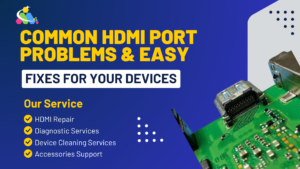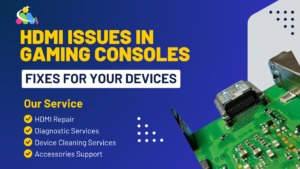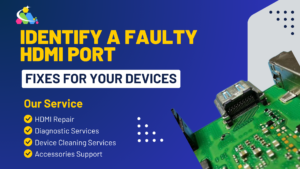HDMI ports play a crucial role in laptops, enabling users to connect external displays, projectors, and TVs for presentations, streaming, and gaming. However, a faulty or damaged HDMI port can disrupt these activities, leading to poor video quality, signal loss, and connectivity issues. In this article, we explore how HDMI ports impact presentations and streaming, common Laptop HDMI Port Issues or problems, and effective solutions to ensure a seamless experience.
Why HDMI Ports Matter for Presentations and Streaming
1. Essential for Professional Presentations
For professionals and students, presentations are a crucial part of meetings, lectures, and conferences. HDMI ports allow you to connect your laptop to a projector or external monitor, ensuring that your audience can see your slides or visuals. A malfunctioning HDMI port can result in:
- No display output
- Blurry or flickering visuals
- Connection disruptions
2. Critical for High-Quality Streaming
Streaming movies, TV shows, or online content on a bigger screen requires a stable HDMI connection. A damaged HDMI port can lead to:
- Audio and video sync issues
- Poor picture resolution
- Frequent disconnections
To enjoy uninterrupted streaming, your laptop’s HDMI port must function correctly, ensuring smooth transmission of both video and audio signals.
Common HDMI Port Issues and Their Impact
1. Loose or Damaged HDMI Port
One of the most frequent problems users face is a loose HDMI connection. This can be caused by repeated plugging and unplugging, leading to wear and tear on the port. Signs of a damaged HDMI port include:
- The cable frequently disconnects
- The screen flickers or shows static
- No signal is detected when connected
2. No Signal Error
When you connect your laptop to a projector or TV, you might see a “No Signal” message. This can be due to:
- A faulty HDMI cable
- Incorrect display settings on your laptop
- A defective HDMI port
3. Audio Not Working
If your HDMI connection transmits video but not audio, the issue could be:
- Incorrect audio settings
- A damaged HDMI port
- Outdated audio drivers
4. Poor Video Quality or Resolution Issues
If your presentation slides or streamed videos appear blurry, pixelated or stretched, the problem could be:
- HDMI version incompatibility
- A low-quality HDMI cable
- Port damage reducing signal transmission
How to Fix Laptop HDMI Port Issues for Better Presentations & Streaming
1. Check and Replace the HDMI Cable
Before assuming that your laptop’s HDMI port is damaged, test your connection with a different HDMI cable. Some cables wear out over time, causing intermittent signal loss.
2. Clean the HDMI Port
Dust and debris inside the HDMI port can cause connectivity issues. Use a small brush or compressed air to clean the port carefully.
3. Update Graphics and Audio Drivers
Outdated drivers can lead to video and audio problems when using HDMI. Update your graphics and sound drivers by following these steps:
- Open Device Manager (Windows) or System Preferences (Mac).
- Locate Display Adapters and Sound, Video, and Game Controllers.
- Right-click and select Update Driver (Windows) or check for updates in MacOS settings.
4. Adjust Display Settings
If your laptop fails to detect an external display, manually adjust the settings:
- Windows Users: Go to Settings > System > Display, then select Extend or Duplicate Display.
- Mac Users: Navigate to System Preferences > Displays, then configure the second screen.
5. Check the HDMI Port for Physical Damage
If your HDMI cable is fine but the issue persists, inspect your laptop’s HDMI port. Look for any bent pins or visible damage. If damaged, professional repair might be necessary.
6. Use an HDMI Adapter or Docking Station
If your laptop’s HDMI port is non-functional, an external HDMI adapter or docking station can serve as a temporary solution.
Preventive Maintenance for Longer HDMI Port Lifespan
To avoid HDMI port problems, follow these simple maintenance tips:
- Avoid frequent plugging and unplugging. Repeatedly connecting and disconnecting the HDMI cable can wear out the port.
- Use high-quality HDMI cables. Cheap cables can damage the port over time due to poor build quality.
- Keep your laptop in a stable position. Avoid pulling or twisting the HDMI cable while in use.
- Regularly clean the HDMI port. Dust buildup can interfere with signal transmission.
When to Seek Professional HDMI Port Repair
If your HDMI port is completely non-functional despite troubleshooting, it might need professional repair. Signs that you need expert HDMI repair include:
- The port is physically broken or bent
- No HDMI connection works, even with different cables
- Your laptop does not detect an external display at all
Professional HDMI repair services can diagnose and fix deep-seated issues, restoring seamless connectivity for presentations and streaming.
Conclusion
A well-functioning HDMI port is crucial for smooth presentations and high-quality streaming. Regular maintenance, careful handling, and prompt troubleshooting can prevent common HDMI problems. If you experience persistent HDMI issues, professional repair services can help restore optimal performance.
By following these tips, you can ensure uninterrupted presentations and an enjoyable streaming experience. If your laptop’s HDMI port needs repair, seek expert help to avoid further damage.





